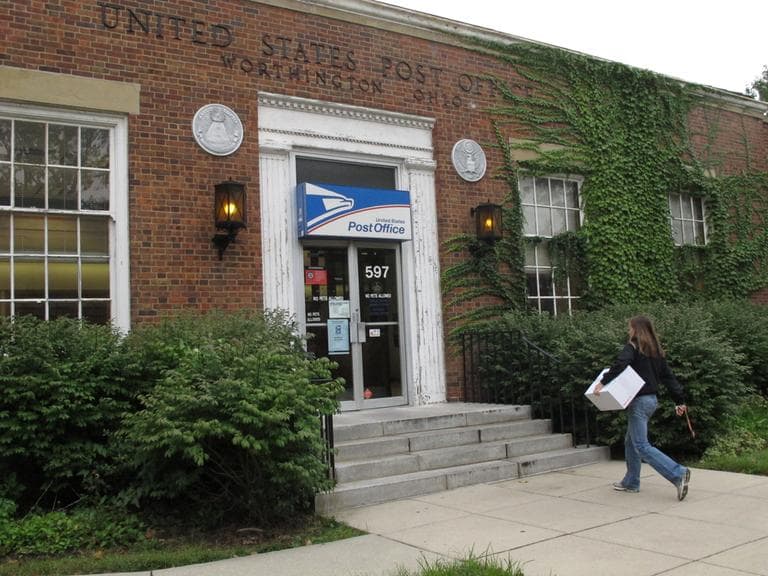Advertisement
The Future Of Snail Mail
ResumeWe’re talking about the U.S. Postal Service, on the brink of default and asking: could we, will we live without the U.S. mail? Or, with a very different postal service?

The United States Postal Service has more than half a million full-time employees. Only Wal-Mart has more.
It delivers mail to the bottom of the Grand Canyon and on snowmobile to the wilds of Alaska.
It was launched by Benjamin Franklin, and has delivered in rain, sleet and snow ever since. And now, the U.S. Mail is –- once again and really, really, really it says –- on the brink of default. Losing money hand over fist. Up against e-mail and Fed Ex and UPS and maybe soon a “death spiral” says the Postmaster General.
This hour On Point: could we, will we, should we live without the U.S. Mail.
-Tom Ashbrook
Guests
Marshall Van Alstyne, an Associate Professor at Boston University and a Visiting Professor at MIT. His work concerns information economics. In designing information goods, this research concerns competitive strategy and network effects.
Philip Herr, director, Physical Infrastructure Issues, Government Accountability Office.
Ed O’Keefe, Federal Eye columnist, Washington Post.
Robert Reisner, president of Transformation Strategy, a management consulting firm.
Highlights
The postal service faces some daunting challenges – it is fast running out of cash in the short-term, but it also faces long-term structural problems due to the shrinking volume of physical mail and the explosion in e-mail.
“Not only is mail volume falling off a cliff, but labor costs are skyrocketing and account for 80 percent of their costs,” Ed O’Keefe, a reporter who covers the federal government for the Washington Post, told On Point today.

One of the main problems drowning the mail service’s books in red ink is the fact that it is required by law to make significant contributions to workers’ retirement funds, to the tune of $5 billion per year. The post office doesn’t have a problem with pre-funding those accounts, said O’Keefe, but they’d rather do it at a lower level, say $1 billion. “It is basically making them go broke every year,” he said.
The country’s mail service is bound to change, but how fast that change will come and in what form, are big unanswered questions. “I’m sure there will be a dramatic evolution in what we mean by a post office, but in the short-term I think it’s a very important institution and critical to the democracy,” said Robert Reisner, president of Transformation Strategy, a management consulting firm, and a former senior official at the U.S. Postal Service.
Marshall Van Alstyne, an associate professor at Boston University, has studied the problems facing the post office and foresees a continuing – if much different – future for the U.S. mail. “[The post office] can become a platform, a purveyor of digital services for other folks – digital archiving, digital secure documents, Van Alstyne said. “We want to see if we can move the direction towards digital goods and services where you can have a sustained revenue stream. The difficulty is that digitization is going to happen, whether they like it or not. The trick is going to be getting efficiency to that.”
With budgets tight and the public in no mood to prop up failing business models, the pressure is on to redefine the post office for the next century.
From Tom's Reading List
The New York Times "The Obama administration said on Tuesday that it would seek to save the deficit-plagued Postal Service from an embarrassing default by proposing to give it an extra three months to make a $5.5 billion payment due on Sept. 30 to finance retirees’ future health coverage."
Bloomberg "The inevitable can’t come quickly enough for some companies. In 2010, for the first time, households reported paying more bills electronically than by mail, according to the most recent USPS Household Diary Study. But only about 15 percent of consumer bills and statements are delivered exclusively online. Businesses spend about $30 billion each year printing, collating, and mailing documents, and a typical bill costs a company anywhere from 70¢ to a dollar to deliver. "
Politico "The USPS, which has lost an average of roughly $7.5 billion a year for the past two years, is maxed out on its $12 billion line of credit with the Treasury Department and could default on a $5.5 billion payment it must make to a retiree health benefits fund by month’s end. That’s on top of the estimated $7 billion to $8 billion the USPS is projected to lose this year."
The Washington Post "Competing legislative proposals from Democrats and Republicans in the House and Senate are pending, and Postmaster General Patrick R. Donahoe wants lawmakers to vote by month’s end, when the Postal Service will have to pay more than $7 billion in statutory labor and health-care costs that Donahoe says are chiefly responsible for its financial collapse."
This program aired on September 13, 2011.